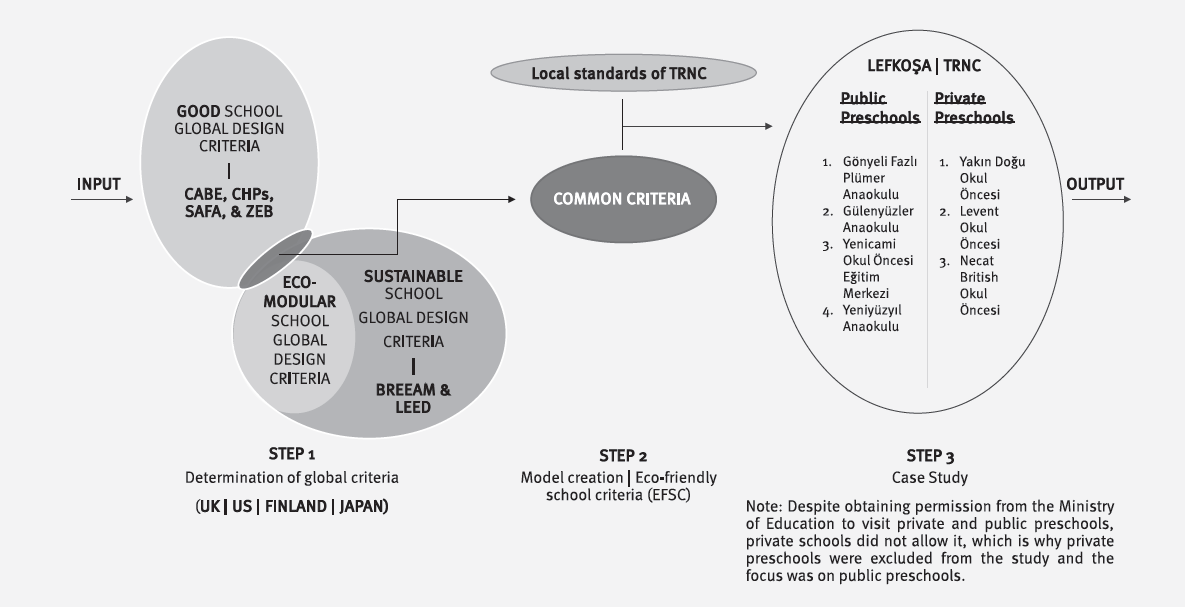Evaluating Pre-School Design in Lefkoşa, Northern Cyprus, Based on Global Sustainability Criteria
DOI:
https://doi.org/10.31522/p.33.1(69).6Keywords:
educatıonal spaces, global crıterıa, pre-school design, school-desıgn standards, sustaınable desıgnAbstract
Considering the design of schools is of utmost importance, especially in the early stages of education. When evaluating pre-schools in Lefkoşa, North Cyprus, we see that the emphasis is on providing classical design standards rather than modern standards. The common standards of global school design standards were collected and harmonized to form the criteria for the study under the title of “Eco-Friendly School Criteria” (EFSC) and then harmonized in the form of a questionnaire that was followed in the re-evaluation process of four public schools in Lefkoşa, North Cyprus. The aim of this study is to show the importance of increasing the scope of knowledge in North Cyprus about the concept of pre-school design, and to re-evaluate it to consider the extent to which the current design of schools conforms to the EFSC standards while taking into account local standards. The results showed that the average compliance rate of these schools with the EFSC standards is 68/110, which indicates a lack in providing a sustainable and comfortable learning environment for the user, including people with disabilities, to make them feel a sense of belonging to the place.
References
Bademcioğlu, M. (2017) Okul binalarının yeşil okul kriterlerine göre değerlendirilmesi (İstanbul ili örneği). Doctoral dissertation, Yüksek Lisans Tezi, Yıldız Teknik Üniversitesi Sosyal Bilimler Enstitüsü Eğitim Bilimleri Bölümü, İstanbul.
Baker, L. (2012) A History of School Design and Its Indoor Environmental Standards, 1900 to Today. National Clearinghouse for Educational Facilities.
Bavilolyaei, B.F. (2012) Yeşil okul tasarım kriterleri uluslararası LEED değerlendirme sertifikası ve uygulaması. Graduate School of Natural and Applied Sciences Gazi University, Ankara.
Boeri, A. and Longo, D. (2013) ‘Environmental quality and energy efficiency: sustainable school buildings design strategies’. International Journal of Sustainable Development and Planning, 8(2), pp. 140-157. https://doi.org/10.2495/SDP-V8-N2-140-157
Çakır, S. (2017) Yeşil Okul Tasarım Ölçütlerinin İrdelenmesi: Türkiye’deki Mevcu Okul Binaları Üzerinde Örnekleme. Doctoral dissertation, Yüksek Lisans Tezi. İstanbul: Yıldız Teknik Üniversitesi.
Çanli, S. (2019) Bir ilkokul binasının pasif okul kriterlerine göre performansının değerlendirilmesi ve iyileştirilmesi. Master’s thesis, Fen Bilimleri Enstitüsü.
Filanova, T.V.; Zhuravlev, M.Y. and Mikhaylova, E.A. (2019) A new approach to the design of preschool institutions. In: E3S Web of Conferences, Vol. 110, p. 01015. EDP Sciences. https://doi.org/10.1051/e3sconf/201911001015
Ford, A. (2007) Designing the sustainable school. Images Publishing.
Gelfand, L. (2010) Sustainable school architecture: Design for elementary and secondary schools. John Wiley & Sons.
Green, M.W. (1999) The appropriate and effective use of security technologies in US schools: A guide for schools and law enforcement agencies. US Department of Justice, Office of Justice Programs, National Institute of Justice.
Gysbers, N.C. (2001) ‘School guidance and counseling in the 21st century: Remember the past into the future’. Professional School Counseling, 5(2), p. 96.
Hille, T. (2011) Modern schools: a century of design for education. John Wiley & Sons.
Jugueta, K.T. (2020) Rethinking the Design of Portable Classrooms. Doctoral dissertation, University of Hawai’i at Manoa.
Lovec, V.; Premrov, M. and Žegarac Leskovar, V. (2020) ‘Thermal comfort and indoor air quality after a partially energy-efficient renovation of a prefabricated concrete kindergarten constructed in 1980’s in Slovenia’. Prostor, 28(2/60/), pp. 346-359. https://doi.org/10.31522/p.28.2(60).10
Makriyianni, C.; Psaltis, C. and Latif, D. (2011) History teaching in Cyprus. Facing mapping, bridging diversity: Foundations of a European discourse on history education, Part 1.
Marable, S.A. (2014) Green Schools - The Implementation and Practices of Environmental
Education in LEED and Used Green Ribbon Public Schools in Virginia. Doctoral dissertation, Virginia Polytechnic Institute and State University.
Menting, J. and Broersma, S. (2016) The comparison of LEED and BREEAM to find a universal way of rating sustainable buildings. Delft University of Technology Faculty of Architecture Explorelab Studio, 21.
Moncaster, A.M. and Simmons, P. (2015) Policies and outcomes for UK sustainable schools. Building Research & Information, 43(4), pp. 452-464. https://doi.org/10.1080/09613218.2015.1005518
Moreau, E. (2020) Rethinking School Design to Promote Safety and Positivity.
Ozer, S. (2017) From enclosure to partition. Defining school design on a pedagogical basis. London K: Architectural Association School of Architecture.
Pise, M. (2006) LEED documentation process: Implementation barriers for school projects. Doctoral dissertation, Virginia Tech.
Sakarya, Ş. (2019) Okul Oncesi Montessori Eğitim Ortamlarının Mekansâl Değerlendirmesi Bursa Orneği. Master’s thesis, Bursa Uludag University, Turkey.
Sanei, M. (2022) ‘The comparative analysis of the scoring system used in BREEAM international new construction 2016 and the recent trends in housing sustainability-related literature’. Prostor, 30(1/63/), pp. 106-125. https://doi.org/10.31522/p.30.1(63).10
Smajlović, A. and Novalić, A. (2020) ‘The importance of local standards in architectural design: A case study of preschool facilities’. International Journal of Sustainable Development and Planning, 15(2), pp. 249-260.
Smajlović Orman, N.; Novalić, A.; Popovac, M. and El Sayed, A. (2023). Sustainable Model of Preschool Education Facilities. In: International Conference “New Technologies, Development and Applications”, May, pp. 299-311. Cham: Springer Nature Switzerland. https://doi.org/10.1007/978-3-031-34721-4_33
Sorrentino, N. (2019) ‘The Design of Spaces for Young Children and Preschool in Emergency’. Athens Journal of Architecture, p. 319. https://doi.org/10.30958/aja.5-4-1
SteelConstruction.info. (2025) BREEAM. Steel Construction. https://www.steelconstruction.info/BREEAM#:~:text=Credits%20achieved%20are%20weighted%20according,encourage%20the%20use%20of%20BREEAM.
Stipanec, S. and Bartolac, A. (2015) ‘Ergonomic Adaptation of Living Space for Preschool Children’. Život i škola: časopis za teoriju i praksu odgoja i obrazovanja, 61(2), pp. 81-92.
Ural, E.C. (2023) Creative thinking and ‘learning spaces’: prototypes in primary school design in Turkey. Master’s thesis, Middle East Technical University.
U.S. Green Building Council. (2025) Credits. LEED credit library. http://usgbc.org/credits?Version=%22v4.1%22&Category=%22Regional+priority%22
Valjan Vukić, V. (2012) ‘Role of environment in encouraging development and learning in preschool age’. Magistra Iadertina, 7(1), pp. 123-132. https://doi.org/10.15291/magistra.824
Wihardjo, S.D.; Hartati, S.; Nurani, Y. and Sujarwanta, A. (2017) ‘The Effects of Green Schooling Knowledge Level and Intensity of Parental Guidance on the Environmental Awareness of the Early Age Student’. Educational Research and Reviews, 12(5), pp. 251-257. https://doi.org/10.5897/ERR2015.2608
Zaunstöck, H. and Grunewald, T. (2022) Early modern educational architectures: The “School Town” of the Francke Foundations in international and interdisciplinary perspective. Francke Foundations. https://www.francke-halle.de/en/science/research-centre/conferences/earlymodern-educational-architectures

Downloads
Published
Issue
Section
License
Copyright (c) 2025 Rasha Tarboush, Çimen Özburak

This work is licensed under a Creative Commons Attribution 4.0 International License.
Copyright (c) 2021 authors and journal.
This work is licensed under a Creative Commons Attribution 4.0 International License.
Authors who publish with this journal agree to the following terms:
In agreeing this form, you certify that:
- You read the ethical codex of the PROSTOR available at journal web.
- You submitted work is your original work, and has not previously been published and does not include any form of plagiarism.
- You own copyright in the submitted work, and are therefore permitted to assign the licence to publish to PROSTOR.
- Your submitted work contains no violation of any existing copyright or other third party right or any material of an obscene, libellous or otherwise unlawful nature.
- You have obtained permission for and acknowledged the source of any illustrations, diagrams or other material included in the work of which you are not the copyright owner.
- You have taken due care to ensure the accuracy of the work, and that, to the best of your knowledge, there are no false statements made within it.
- All co-authors of this submitted work are aware of, and in agreement with, the terms of this licence and that the submitted manuscript has been approved by these authors.






